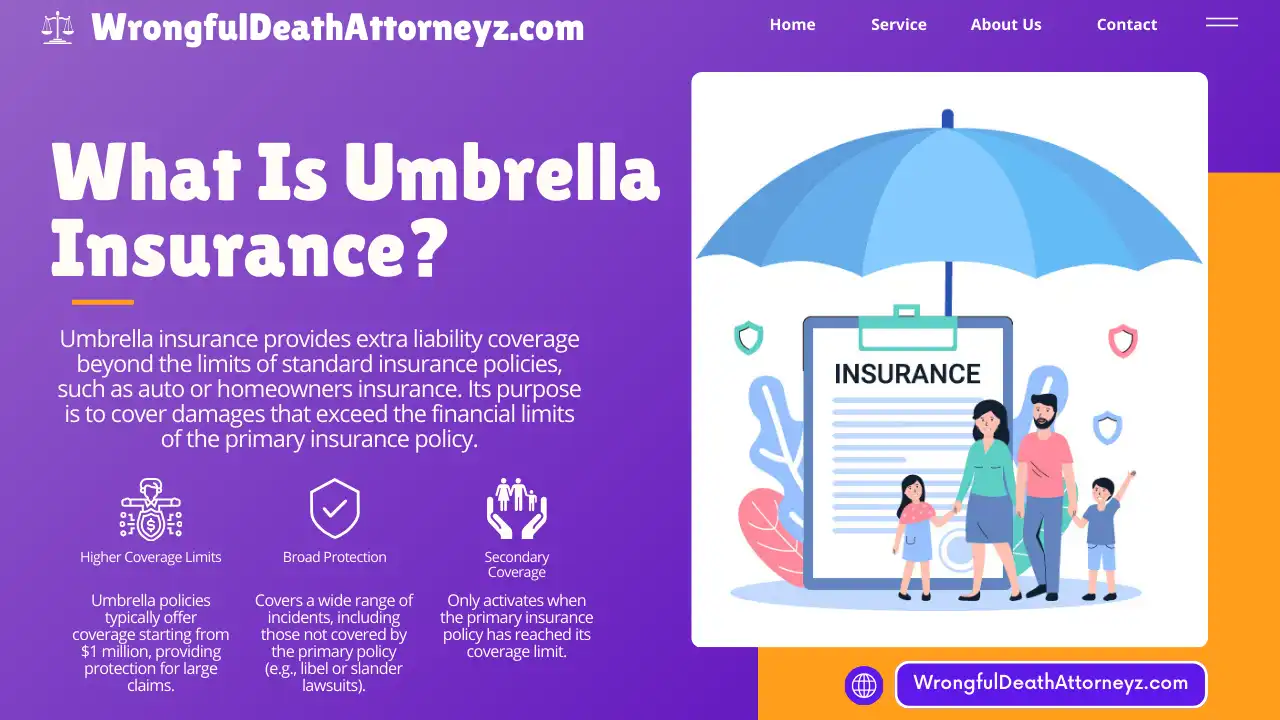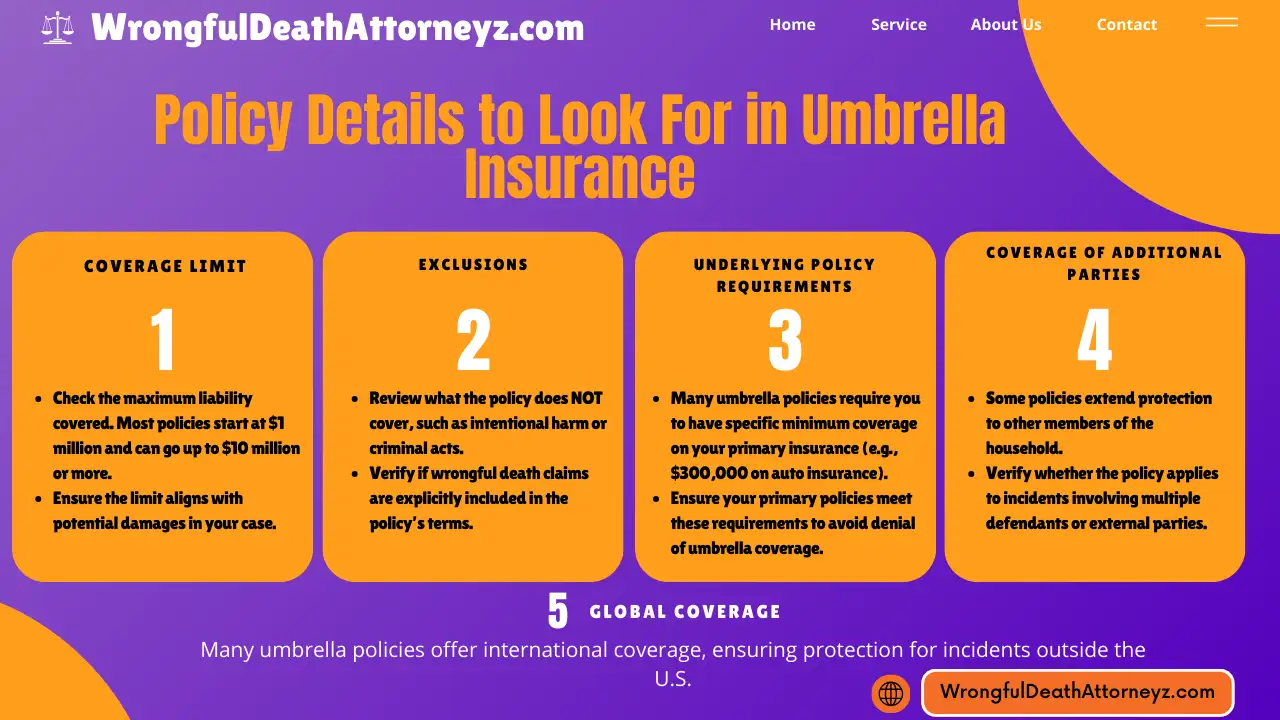Dealing with the aftermath of a wrongful death is emotionally draining, and navigating financial and legal complexities can be equally challenging. Families often depend on settlements to cover medical expenses, funeral costs, and loss of income. In these cases, umbrella insurance policies can play a pivotal role in ensuring adequate compensation when primary insurance coverage falls short.
This article dives into umbrella insurance policies, their role in wrongful death cases, comparisons to standard policies, and how to maximize your settlement.
What Is Umbrella Insurance?

Umbrella insurance provides extra liability coverage beyond the limits of standard insurance policies, such as auto or homeowners insurance. Its purpose is to cover damages that exceed the financial limits of the primary insurance policy.
Key Features of Umbrella Insurance:
- Higher Coverage Limits: Umbrella policies typically offer coverage starting from $1 million, providing protection for large claims.
- Broad Protection: Covers a wide range of incidents, including those not covered by the primary policy (e.g., libel or slander lawsuits).
- Secondary Coverage: Only activates when the primary insurance policy has reached its coverage limit.
How Umbrella Insurance Policies Work in Wrongful Death Cases
- Supplementing Primary Insurance:
If the primary policy’s liability limit is $500,000 and the wrongful death damages total $1.5 million, the umbrella policy can cover the remaining $1 million. - Covering Broader Scenarios:
- Covers claims that might not fall under standard insurance policies, such as negligence cases involving non-vehicle incidents or accidents on rental properties.
- May extend coverage to family members of the policyholder, depending on the terms.
- Protecting Defendants’ Assets:
By paying claims that exceed the primary insurance, umbrella policies shield the liable party’s personal or business assets from being liquidated to satisfy the settlement.
Check More – Wrongful Death Case Checklist
Comparing Umbrella Insurance and Standard Insurance Policies
| Feature | Standard Insurance | Umbrella Insurance |
|---|---|---|
| Coverage Amount | Limited to policy cap (e.g., $100,000–$500,000). | Extends beyond primary coverage, often starting at $1 million. |
| Cost | Lower premiums. | Moderate additional premium (varies based on coverage). |
| Scenarios Covered | Specific situations (e.g., auto accidents, homeowner liabilities). | Covers broader situations, including libel, slander, and rental liabilities. |
| Activation | Immediate coverage upon filing a claim. | Kicks in only after primary coverage is exhausted. |
| Applicability Across Policies | Limited to one policy type (e.g., auto or home). | Can extend to multiple underlying policies. |
Example:
Imagine a wrongful death caused by a car accident.
- Standard Auto Insurance: Covers up to $500,000.
- Umbrella Insurance: Covers the excess, such as the remaining $1 million in a $1.5 million claim.
In this scenario, without an umbrella policy, the liable party may face personal financial ruin to cover the gap.

Policy Details to Look For in Umbrella Insurance
- Coverage Limit:
- Check the maximum liability covered. Most policies start at $1 million and can go up to $10 million or more.
- Ensure the limit aligns with potential damages in your case.
- Exclusions:
- Review what the policy does NOT cover, such as intentional harm or criminal acts.
- Verify if wrongful death claims are explicitly included in the policy’s terms.
- Underlying Policy Requirements:
- Many umbrella policies require you to have specific minimum coverage on your primary insurance (e.g., $300,000 on auto insurance).
- Ensure your primary policies meet these requirements to avoid denial of umbrella coverage.
- Coverage of Additional Parties:
- Some policies extend protection to other members of the household.
- Verify whether the policy applies to incidents involving multiple defendants or external parties.
- Global Coverage:
- Many umbrella policies offer international coverage, ensuring protection for incidents outside the U.S.
Why Umbrella Insurance Can Be Critical in Wrongful Death Cases
- Ensures Full Compensation:
Wrongful death cases often involve high-value claims, including medical bills, loss of income, and emotional damages. Umbrella insurance ensures the victim’s family receives adequate compensation, even if the primary policy falls short. - Protects the Defendant:
Umbrella insurance protects the assets of the liable party, reducing the risk of bankruptcy or liquidation. - Streamlines Settlements:
Insurance companies are more likely to settle quickly and fairly when umbrella coverage is available, as it reduces the need for prolonged litigation.
Challenges When Dealing with Umbrella Insurance in Wrongful Death Claims
- Hidden Policies:
Defendants may not disclose the existence of an umbrella policy. A skilled attorney can uncover these policies during the discovery process. - Complex Legal Language:
Umbrella insurance policies often have dense legal terms that can be difficult to interpret. Consulting an attorney is crucial to fully understand your rights. - Proving Liability:
Insurance companies may aggressively challenge liability to avoid large payouts. Strong evidence and legal representation are essential.
Pro Tips for Maximizing Settlements with Umbrella Insurance
- Thorough Investigation:
Work with your attorney to uncover all potential insurance policies, including umbrella coverage. - Leverage Policy Terms:
Ensure the terms of the umbrella policy are fully explored to maximize your compensation. - Negotiate Strategically:
Insurance companies often prefer to settle out of court when umbrella policies are involved. A skilled attorney can leverage this to secure a fair settlement.
FAQ’s
1. What is the main purpose of umbrella insurance in wrongful death cases?
Umbrella insurance provides additional liability coverage beyond the limits of standard insurance policies, ensuring that victims’ families receive adequate compensation when the primary policy’s limits are exceeded.
2. How can I find out if the liable party has an umbrella insurance policy?
Uncovering an umbrella policy may require legal intervention. Your attorney can request the disclosure of all insurance policies during the discovery phase of the legal process.
3. Does umbrella insurance cover wrongful death caused by intentional acts?
Typically, umbrella insurance does not cover intentional acts or criminal behavior. It is designed to cover damages from negligence, recklessness, or unintentional harm.
4. How much coverage does an umbrella insurance policy usually provide?
Most umbrella insurance policies start at $1 million in additional liability coverage. Depending on the policy, this can extend to $10 million or more.
5. How does umbrella insurance compare to excess liability insurance?
While both provide additional coverage, umbrella insurance often covers broader situations, such as libel or slander, which may not be included in excess liability insurance. Excess liability insurance typically only increases the limits of existing policies without adding broader coverage.
6. Can umbrella insurance help protect the defendant’s assets?
Yes, umbrella insurance prevents the defendant from having to liquidate personal or business assets to pay for damages that exceed their primary insurance coverage.
Conclusion: Why Understanding Umbrella Insurance Matters
Umbrella insurance can significantly impact wrongful death settlements, providing financial relief when primary policies fall short. By understanding its role, policy terms, and how it compares to standard insurance, families can navigate the complexities of wrongful death claims more effectively.
To maximize your compensation and ensure justice, consult an experienced wrongful death attorney who can guide you through the intricacies of insurance policies. Whether you’re dealing with an auto accident, workplace fatality, or another tragic event, knowing how umbrella insurance works could make all the difference in your case.